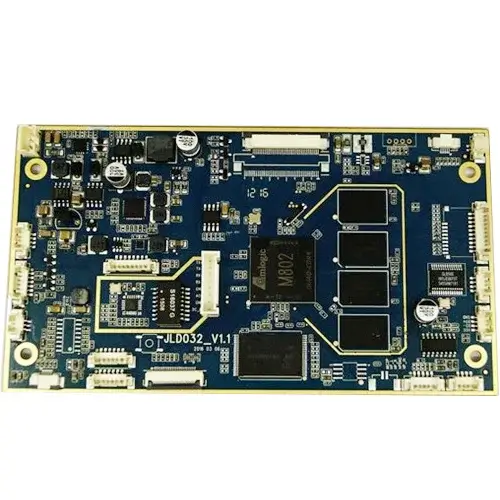
Automotive PCBs are crucial for the performance and reliability of modern vehicles, supporting systems from engine controls to infotainment.
Each car, however, is under slight constant vibrations from the engine, road surface, and vehicle movement, each of which may cause physical stress on the PCBs, eventually leading to their damage or failure if not correctly designed.
Temperature extremes are another challenge. Inside a car, temperatures can swing from freezing cold in winter to scorching heat in summer, with even more extreme conditions under the hood. PCBs must operate reliably across this wide range without performance issues.
Further, the PCB within automobiles is constantly exposed to some moisture levels, perhaps due to the humidity of the environment or even through condensation, and to the chemicals infiltrated within in the form of oils, fuels, and cleaning agents.
This consequently means that if not well protected, the PCB could be further affected by corrosion and other damages. It’s crucial to comprehend these severe conditions, a critical factor in ensuring that automotive PCBs have been designed and are made up to the demands of the rigid requirements of the automotive industry.
Now let’s discuss the quality standards and regulations for automotive PCB manufacturing.
The high demands set by the automotive industry with regard to quality and reliability for automotive PCBs must be considered.
Of course, compliance with such standards ensures that the PCBs can work satisfactorily under the very hostile conditions inside a vehicle.
AEC-Q-2000, better known as the Automotive Electronics Council, demands a quality and reliability benchmark for electronic components used in the automotive industry. The conformance based on AEC-Q-2000 requires PCBs to withstand vibrations, temperature ranges, high humidity, chemicals, and other vehicle environmental standards.
Besides AEC-Q-2000, IPC-A-610 is one of the oldest standards for the acceptability of electronic assemblies. Meaning it details the criteria for artistry regarding a PCB, thus helping a manufacturer maintain high-quality levels.
ISO 9001 is another essential certification to ensure the company works with effectiveness and consistency in terms of quality management
Adherence to ISO 9001 results in standardized quality for production, ensuring the reliability of automotive PCBs.
The material you select for use in automotive PCBs is critical in determining how durable and reliable they will be.
Below are tips on choosing these materials.
Well-designed automotive PCBs have to pay serious attention to critical parameters that call the shots toward the performance and reliability of the circuit.
Automotive PCBs have to be designed to withstand the vibrations and extreme impacts in vehicle operations.
These include securing specific components with materials capable of absorbing or dampening the vibration forces/opposing inevitable threats to cause damage.
Component failure may happen due to high temperatures in the vehicle itself, so correct dissipation of heat might be an essential thing to do.
Through the use of parlous PCB design that captures essential thermal management techniques—such as heat sinks, thermal vias, and proper airflow—this ensures that the assembly always operates at the manufacturer-specified optimal temperatures.
Manufacturing automotive PCBs involves advanced techniques and stringent controls to ensure high quality and reliability.
This can involve using high-layer count PCBs for more complex designs. With laser drilling, microvias can be used for dense circuitry, and improved signal integrity and tight tolerance control will retain precision on dimensions and electrical performance.
It has a production management system that is stricter and involves serious monitoring at every stage, such that deviations—should there happen to be any—are detected and rectified with little delay.
Ensuring recognition and compliance with standards, maintaining good product consistency, and being reliable are all attained.
Sophisticated inspection methods such as X-ray and automated optical inspection ensure checking the integrity of the PCB assemblies.
These techniques ensure correct component placement, the strength of solder joints, and the exclusion of hidden defects that might be detrimental to performance.
Efficient assembly of automotive PCBs requires specialized techniques to ensure durability and reliability in demanding environments.
High-precision pick-and-place machines handle the task of accurate placement of parts in automotive PCB assembly. They place automotive-grade components that can tough out conditions such as vibration, pressure, temperature change, and so on.
These lead-free soldering processes are not only crucial for the environment but also to provide effective, efficient, and reliable electrical connections.
Controlled soldering techniques do not cause cold solders, an excess of solder, or other faults that may deteriorate printed board performance.
Applying advanced conformal coating is essential to protect PCBs from moisture, chemicals, and temperature extremes encountered in automotive applications.
This protective layer enhances reliability by shielding sensitive components and preventing corrosion.
Testing and inspection at each process are the essential parts of ensuring that an automotive PCB meets all the requirements concerning its reliability and performance.
In conclusion, making reliable automotive PCBs is challenging because of the tough conditions in cars. By focusing on choosing the right materials, careful design, and detailed testing, manufacturers can create PCBs that meet strict automotive industry standards.
This approach improves reliability and ensures that automotive electronics work well throughout the vehicle’s life, giving confidence to manufacturers and customers alike.
Fill in your requirement information and upload Gerber and BOM files, we will give you a quote within 24 hours.
Fill in your requirement information and upload Gerber and BOM files, we will give you a quote within 24 hours.